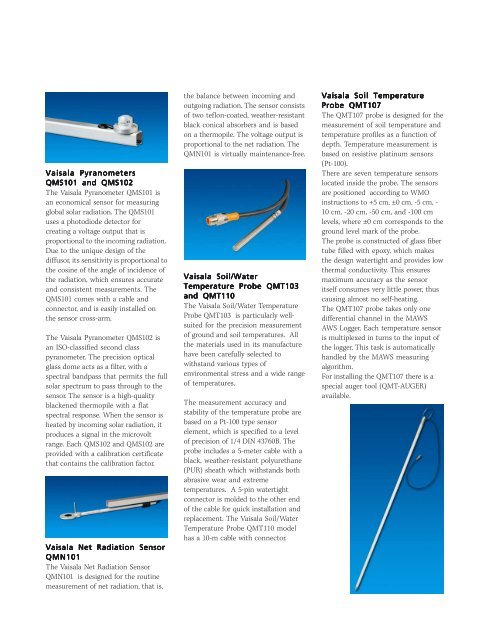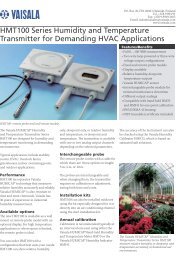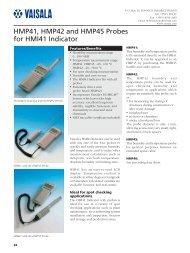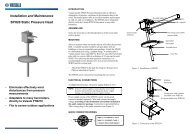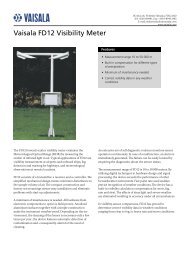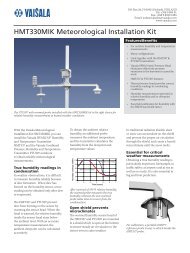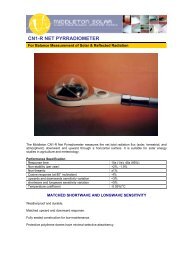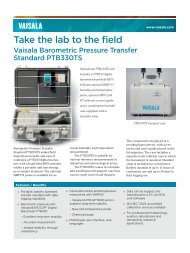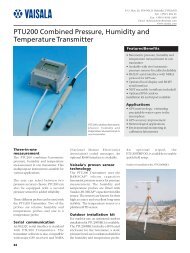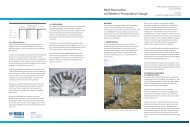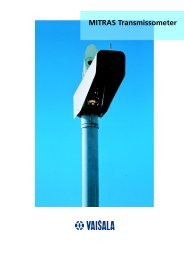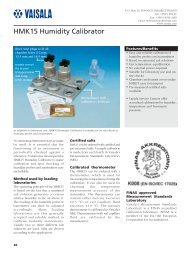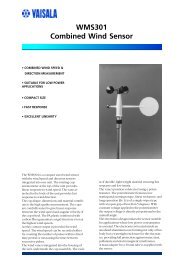Vaisala Sensors
Vaisala Sensors
Vaisala Sensors
You also want an ePaper? Increase the reach of your titles
YUMPU automatically turns print PDFs into web optimized ePapers that Google loves.
<strong>Vaisala</strong> Pyranometers<br />
QMS101 and QMS102<br />
The <strong>Vaisala</strong> Pyranometer QMS101 is<br />
an economical sensor for measuring<br />
global solar radiation. The QMS101<br />
uses a photodiode detector for<br />
creating a voltage output that is<br />
proportional to the incoming radiation.<br />
Due to the unique design of the<br />
diffusor, its sensitivity is proportional to<br />
the cosine of the angle of incidence of<br />
the radiation, which ensures accurate<br />
and consistent measurements. The<br />
QMS101 comes with a cable and<br />
connector, and is easily installed on<br />
the sensor cross-arm.<br />
The <strong>Vaisala</strong> Pyranometer QMS102 is<br />
an ISO-classified second class<br />
pyranometer. The precision optical<br />
glass dome acts as a filter, with a<br />
spectral bandpass that permits the full<br />
solar spectrum to pass through to the<br />
sensor. The sensor is a high-quality<br />
blackened thermopile with a flat<br />
spectral response. When the sensor is<br />
heated by incoming solar radiation, it<br />
produces a signal in the microvolt<br />
range. Each QMS102 and QMS102 are<br />
provided with a calibration certificate<br />
that contains the calibration factor.<br />
<strong>Vaisala</strong> Net Radiation Sensor<br />
QMN101<br />
The <strong>Vaisala</strong> Net Radiation Sensor<br />
QMN101 is designed for the routine<br />
measurement of net radiation, that is,<br />
the balance between incoming and<br />
outgoing radiation. The sensor consists<br />
of two teflon-coated, weather-resistant<br />
black conical absorbers and is based<br />
on a thermopile. The voltage output is<br />
proportional to the net radiation. The<br />
QMN101 is virtually maintenance-free.<br />
<strong>Vaisala</strong> Soil/Water<br />
Temperature Probe QMT103<br />
and QMT110<br />
The <strong>Vaisala</strong> Soil/Water Temperature<br />
Probe QMT103 is particularly wellsuited<br />
for the precision measurement<br />
of ground and soil temperatures. All<br />
the materials used in its manufacture<br />
have been carefully selected to<br />
withstand various types of<br />
environmental stress and a wide range<br />
of temperatures.<br />
The measurement accuracy and<br />
stability of the temperature probe are<br />
based on a Pt-100 type sensor<br />
element, which is specified to a level<br />
of precision of 1/4 DIN 43760B. The<br />
probe includes a 5-meter cable with a<br />
black, weather-resistant polyurethane<br />
(PUR) sheath which withstands both<br />
abrasive wear and extreme<br />
temperatures. A 5-pin watertight<br />
connector is molded to the other end<br />
of the cable for quick installation and<br />
replacement. The <strong>Vaisala</strong> Soil/Water<br />
Temperature Probe QMT110 model<br />
has a 10-m cable with connector.<br />
<strong>Vaisala</strong> Soil Temperature<br />
Probe QMT107<br />
The QMT107 probe is designed for the<br />
measurement of soil temperature and<br />
temperature profiles as a function of<br />
depth. Temperature measurement is<br />
based on resistive platinum sensors<br />
(Pt-100).<br />
There are seven temperature sensors<br />
located inside the probe. The sensors<br />
are positioned according to WMO<br />
instructions to +5 cm, ±0 cm, -5 cm, -<br />
10 cm, -20 cm, -50 cm, and -100 cm<br />
levels, where ±0 cm corresponds to the<br />
ground level mark of the probe.<br />
The probe is constructed of glass fiber<br />
tube filled with epoxy, which makes<br />
the design watertight and provides low<br />
thermal conductivity. This ensures<br />
maximum accuracy as the sensor<br />
itself consumes very little power, thus<br />
causing almost no self-heating.<br />
The QMT107 probe takes only one<br />
differential channel in the MAWS<br />
AWS Logger. Each temperature sensor<br />
is multiplexed in turns to the input of<br />
the logger. This task is automatically<br />
handled by the MAWS measuring<br />
algorithm.<br />
For installing the QMT107 there is a<br />
special auger tool (QMT-AUGER)<br />
available.


